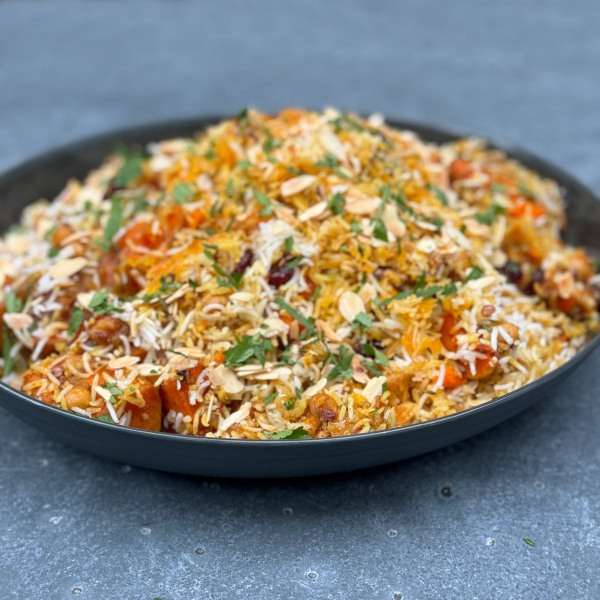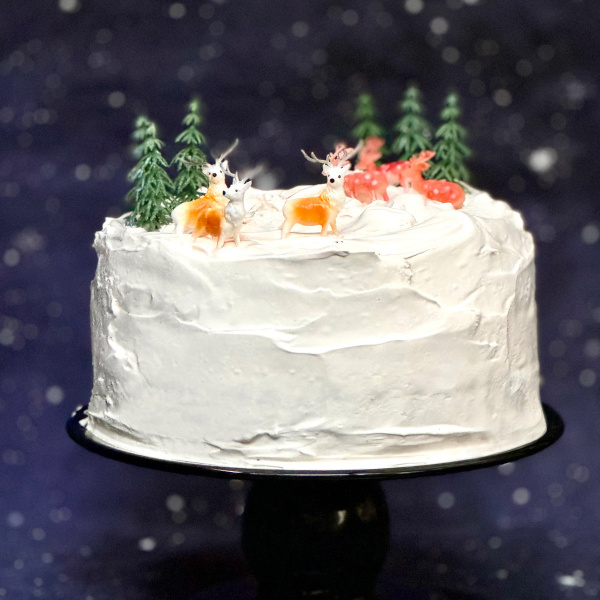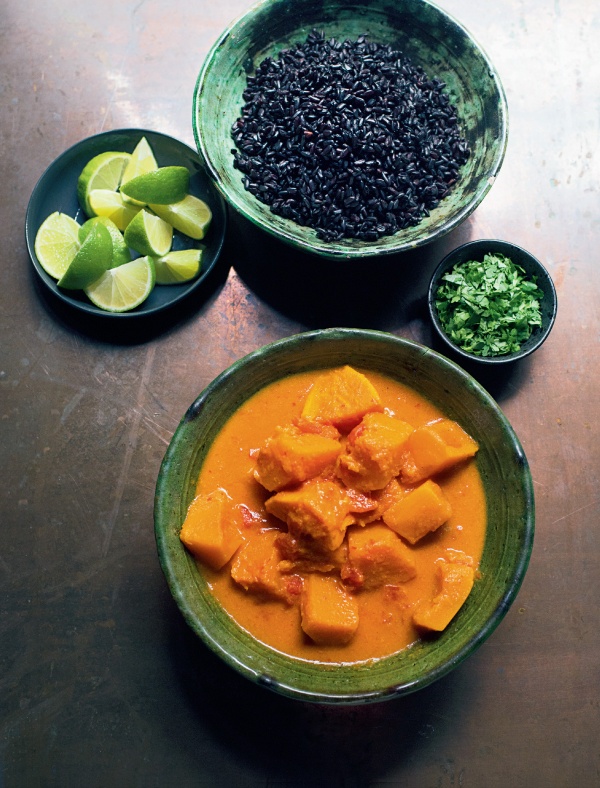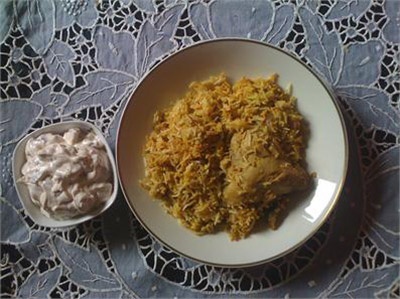Butternut Biryani
by NigellaIntroduction
This is the vegan version of my Indonesian-Inspired Chicken Biryani, although it is splendid enough in its own right. Still, this is how it came to be, though I thought it would be easier for you to have it as a standalone recipe. For even though most of the recipe is exactly the same as for the chicken — apart from replacing the chicken with butternut squash, the regular plain yogurt with coconut milk yogurt, and adding some chickpeas — you do cook the initial stage a little differently.
I should say, too, that I’ve also made this in exactly the same way with cauliflower, and very good it was, too, though I feel the butternut gives it more of a party feel. And by the way, even if you wish this to be vegetarian rather than vegan, I would still advise using coconut-milk yogurt as I think it needs that extra richness.
For maximum pleasure — and isn’t that the aim in life? — serve with the Pineapple-Plus Salad with Rujak Dressing, replacing the fermented shrimp paste with 1 teaspoon of miso and a drop of vegan ‘fish’ sauce.
And please read the Additional Information section at the end of the recipe before proceeding.
This is the vegan version of my Indonesian-Inspired Chicken Biryani, although it is splendid enough in its own right. Still, this is how it came to be, though I thought it would be easier for you to have it as a standalone recipe. For even though most of the recipe is exactly the same as for the chicken — apart from replacing the chicken with butternut squash, the regular plain yogurt with coconut milk yogurt, and adding some chickpeas — you do cook the initial stage a little differently.
I should say, too, that I’ve also made this in exactly the same way with cauliflower, and very good it was, too, though I feel the butternut gives it more of a party feel. And by the way, even if you wish this to be vegetarian rather than vegan, I would still advise using coconut-milk yogurt as I think it needs that extra richness.
For maximum pleasure — and isn’t that the aim in life? — serve with the Pineapple-Plus Salad with Rujak Dressing, replacing the fermented shrimp paste with 1 teaspoon of miso and a drop of vegan ‘fish’ sauce.
And please read the Additional Information section at the end of the recipe before proceeding.

Share or save this
Ingredients
Serves: 8
For the butternut
- 1 large butternut squash (1-1¼kg/2¼-2½lb), de-seeded with skin kept on and cut into chunky bite-sized pieces
- 2 tablespoons vegetable oil
- 1 teaspoon sea salt flakes or half a teaspoon fine sea salt
FOR THE SAUCE
- 3 medium onions (approx. 500g/1lb 2oz) peeled and cut into fine half-moons
- 4 tablespoons vegetable oil
- 150 grams coconut milk yogurt
- 4 tablespoons sambal oelek
- 2 tablespoons kecap manis
- 1 tablespoon tamarind paste
- 1 tablespoon freshly grated ginger
- 2 fat cloves of garlic (peeled and grated)
- 2 teaspoons ground cinnamon
- 1 teaspoon ground cardamom
- 1 teaspoon ground turmeric
- ½ teaspoon fine sea salt
- 1 tablespoon vegetable oil
- 1 x 400 grams can chickpeas (drained)
FOR THE RICE
- 4 cardamom pods (crushed)
- 1 long or 2 short cinnamon sticks
- 2 cloves
- 3 star anise
- 25 grams desiccated coconut
- 2 teaspoons pink peppercorns
- 2 litres cold water
- 2 teaspoons fine sea salt
- 2 teaspoons sesame oil
- 1 teaspoon lime juice
- 600 grams basmati rice
FOR LAYERING UP
- 1 teaspoon sesame oil
- 2 teaspoons cumin seeds (toasted)
- 25 grams desiccated coconut
- 50 grams dried cranberries
TO SERVE
- 50 grams flaked almonds (toasted)
- fresh coriander (chopped)
For the butternut
- 1 large butternut squash (1-1¼kg/2¼-2½lb), de-seeded with skin kept on and cut into chunky bite-sized pieces
- 2 tablespoons vegetable oil
- 1 teaspoon sea salt flakes or half a teaspoon fine sea salt
FOR THE SAUCE
- 3 medium onions (approx. 500g/1lb 2oz) peeled and cut into fine half-moons
- ¼ cup vegetable oil
- ⅔ cup coconut milk yogurt
- 4 tablespoons sambal oelek
- 2 tablespoons kecap manis
- 1 tablespoon tamarind paste
- 1 tablespoon freshly grated ginger
- 2 fat cloves of garlic (peeled and grated)
- 2 teaspoons ground cinnamon
- 1 teaspoon ground cardamom
- 1 teaspoon ground turmeric
- ½ teaspoon fine sea salt
- 1 tablespoon vegetable oil
- 1 x 15 ounce can garbanzo beans (drained)
FOR THE RICE
- 4 cardamom pods (crushed)
- 1 long or 2 short cinnamon sticks
- 2 cloves
- 3 star anise
- ⅓ cup unsweetened shredded coconut
- 2 teaspoons pink peppercorns
- 8 cups cold water
- 2 teaspoons fine sea salt
- 2 teaspoons asian sesame oil
- 1 teaspoon lime juice
- 3 cups basmati rice
FOR LAYERING UP
- 1 teaspoon asian sesame oil
- 2 teaspoons cumin seeds (toasted)
- ⅓ cup unsweetened shredded coconut
- ⅓ cup dried cranberries
TO SERVE
- ½ cup sliced almonds (toasted)
- cilantro (chopped)
Method
- Heat the oven to 200ºC/180ºC Fan/400ºF. Arrange the butternut chunks into a shallow baking tray, pour over the 2 tablespoons of vegetable oil, and give it all a good schmoosh in order coat the prepared butternut. Sprinkle with salt and roast for 30-40 minutes, or until it feels soft (but only just) all the way through when you pierce the orange flesh with a fork.
- While it’s still in the oven, however, you can get on with the sauce, so first off slice your onions, and warm the 4 tablespoons/ quarter cup of vegetable oil in a very large preferably non-stick pan that comes with a lid; I use one that’s a whisper under 32cm/13in, though you could get away one slightly smaller.
- Add the onions, give a good stir, then cook them on high for the first 5 minutes, then turn down the heat, and carry on cooking for 25-30 minutes, stirring frequently and adjusting the heat as necessary, until very soft but still pale. And in between stirs, mix up all the remaining sauce ingredients in a jug, and have it on standby.
- Once the onions are good and soft, pour in the spicy yogurt mixture, scraping the jug out well, and stir it into the onions. Cook at a gentle simmer for 12-15 minutes, uncovered. When it’s ready, the sauce will have darkened a little and the oil will have begun to separate, so take the pan off the heat when this happens.
- At this point, add the drained chickpeas and stir them into the sauce. Once the butternut is cooked, which should be about now anyway, carefully add the tender, vibrant chunks, making sure you don’t mash the pieces: just turn everything together gently and then put on the lid to keep warm off the heat while you get on with your rice.
- I begin with scenting the water it’s going to cook in to make the rice gorgeously aromatic. So, drop the cardamom pods into a large pan with a good sturdy base and a tightly fitting lid (I use one of 26cm/10in diameter, with a capacity of 5.3 litres/quarts) followed by the cinnamon stick or sticks, 2 cloves, 3 star anise, 25g/⅓ cup desiccated coconut and 2 teaspoons of pink peppercorns — which looks beautifully christmassy. Pour over the 2 litres/8 cups of water, add 2 tablespoons of fine salt, a teaspoon of lime juice and 2 teaspoons of sesame oil and bring to a boil with the lid on. Once it comes to the boil, you can switch the heat off, and leave it on the warm hob, covered, to let the water gloriously infuse.
- Meanwhile, rinse the rice and leave it in a bowl covered with cold water to soak for 30 minutes but no longer. Towards the end of the 30 minutes, bring the water back to the boil. Drain the rice well, and use a slotted spoon to add it gradually to the boiling scented water; if you dump it in all at once, it’ll make the temperature of the water drop too much. Put the lid on to let it come back to a boil faster (though keep checking it has come back to a proper boil), and once it has, boil for 2 minutes with the lid on. Test the rice is cooked enough by rubbing a grain of rice between your fingers to see if it breaks into 2 or 3 bits, before draining well.
- Wipe the pan out well, and brush the bottom with a teaspoon of sesame oil, then spoon in half of the rice. Scatter over half of the toasted cumin seeds, half of the desiccated coconut, and half of the cranberries, and arrange the still-warm butternut, chickpeas and onions in their oniony sauce in an even layer on top of the rice, scraping over any sauce that remains in the pan.
- Cover with the rest of the rice, and scatter again with the remaining cumin, coconut and cranberries.
- Make a tight seal on top of the pot with foil and then put the lid on. Place over medium heat for 4-5 minutes, to let the steam build up — you should be able to hear when it starts bubbling — and then turn down for a further 15-16 minutes more on low, to give it 20 minutes in total.
- Turn off the flame (or take the pan off the heat) and carefully remove the foil — you should be greeted with a gentle puff of steam — and replace it with a clean tea towel, then clamp the lid back on, and leave for a further 20 minutes off the heat, though more wouldn’t matter.
- Spoon the biryani out onto a platter or shallow bowl, scraping out the bottom of the pot to add the crispy bits to the serving dish. Scatter with the toasted almonds as you go so that they are mixed into the whole dish, with a final scatter on top, finishing with the chopped coriander.
- Heat the oven to 200ºC/180ºC Fan/400ºF. Arrange the butternut chunks into a shallow baking tray, pour over the 2 tablespoons of vegetable oil, and give it all a good schmoosh in order coat the prepared butternut. Sprinkle with salt and roast for 30-40 minutes, or until it feels soft (but only just) all the way through when you pierce the orange flesh with a fork.
- While it’s still in the oven, however, you can get on with the sauce, so first off slice your onions, and warm the 4 tablespoons/ quarter cup of vegetable oil in a very large preferably non-stick pan that comes with a lid; I use one that’s a whisper under 32cm/13in, though you could get away one slightly smaller.
- Add the onions, give a good stir, then cook them on high for the first 5 minutes, then turn down the heat, and carry on cooking for 25-30 minutes, stirring frequently and adjusting the heat as necessary, until very soft but still pale. And in between stirs, mix up all the remaining sauce ingredients in a jug, and have it on standby.
- Once the onions are good and soft, pour in the spicy yogurt mixture, scraping the jug out well, and stir it into the onions. Cook at a gentle simmer for 12-15 minutes, uncovered. When it’s ready, the sauce will have darkened a little and the oil will have begun to separate, so take the pan off the heat when this happens.
- At this point, add the drained garbanzo beans and stir them into the sauce. Once the butternut is cooked, which should be about now anyway, carefully add the tender, vibrant chunks, making sure you don’t mash the pieces: just turn everything together gently and then put on the lid to keep warm off the heat while you get on with your rice.
- I begin with scenting the water it’s going to cook in to make the rice gorgeously aromatic. So, drop the cardamom pods into a large pan with a good sturdy base and a tightly fitting lid (I use one of 26cm/10in diameter, with a capacity of 5.3 litres/quarts) followed by the cinnamon stick or sticks, 2 cloves, 3 star anise, 25g/⅓ cup unsweetened shredded coconut and 2 teaspoons of pink peppercorns — which looks beautifully christmassy. Pour over the 2 litres/8 cups of water, add 2 tablespoons of fine salt, a teaspoon of lime juice and 2 teaspoons of asian sesame oil and bring to a boil with the lid on. Once it comes to the boil, you can switch the heat off, and leave it on the warm hob, covered, to let the water gloriously infuse.
- Meanwhile, rinse the rice and leave it in a bowl covered with cold water to soak for 30 minutes but no longer. Towards the end of the 30 minutes, bring the water back to the boil. Drain the rice well, and use a slotted spoon to add it gradually to the boiling scented water; if you dump it in all at once, it’ll make the temperature of the water drop too much. Put the lid on to let it come back to a boil faster (though keep checking it has come back to a proper boil), and once it has, boil for 2 minutes with the lid on. Test the rice is cooked enough by rubbing a grain of rice between your fingers to see if it breaks into 2 or 3 bits, before draining well.
- Wipe the pan out well, and brush the bottom with a teaspoon of asian sesame oil, then spoon in half of the rice. Scatter over half of the toasted cumin seeds, half of the unsweetened shredded coconut, and half of the cranberries, and arrange the still-warm butternut, garbanzo beans and onions in their oniony sauce in an even layer on top of the rice, scraping over any sauce that remains in the pan.
- Cover with the rest of the rice, and scatter again with the remaining cumin, coconut and cranberries.
- Make a tight seal on top of the pot with foil and then put the lid on. Place over medium heat for 4-5 minutes, to let the steam build up — you should be able to hear when it starts bubbling — and then turn down for a further 15-16 minutes more on low, to give it 20 minutes in total.
- Turn off the flame (or take the pan off the heat) and carefully remove the foil — you should be greeted with a gentle puff of steam — and replace it with a clean tea towel, then clamp the lid back on, and leave for a further 20 minutes off the heat, though more wouldn’t matter.
- Spoon the biryani out onto a platter or shallow bowl, scraping out the bottom of the pot to add the crispy bits to the serving dish. Scatter with the toasted almonds as you go so that they are mixed into the whole dish, with a final scatter on top, finishing with the chopped coriander.
Additional Information
If you can’t find the punchy Indonesian chilli sauce Sambal Oelek and treacly Kecap Manis, you could subsitute another chilli sauce, though it's hard to be sure of relative strengths. And you can make your own Kecap Manis following the instructions Lara Lee gives in her lovely book, Coconut & Sambal, namely combine 60ml light soy sauce or gluten-free tamari and 90g palm sugar or brown sugar in a small saucepan, place over a medium heat and bring to a simmer. Turn the heat down to low and simmer gently to reduce and thicken to a sauce with the consistency of maple syrup, which should take no longer than 5 minutes. Leave to cool before using.
MAKE AHEAD:
The butternut squash can be cooked a day ahead. Cover and refrigerate as soon as cool and within 2 hours of cooking. The sauce can be made a day ahead up to the end of step 4. Cool and refrigerate as quickly as possible and within 2 hours and separately from the cooked squash. To serve, put the sauce in a large pan with the drained chickpeas and the butternut squash and put over a medium heat, stirring occasionally, until everything is piping hot.
STORE:
Leftovers must be refrigerated as soon as cool or within 2 hours and will keep in the fridge for up to 2 days. Eat leftovers cold or reheated in individual portions in the microwave until piping hot all of the way through. Serve immediately.
If you can’t find the punchy Indonesian chilli sauce Sambal Oelek and treacly Kecap Manis, you could subsitute another chilli sauce, though it's hard to be sure of relative strengths. And you can make your own Kecap Manis following the instructions Lara Lee gives in her lovely book, Coconut & Sambal, namely combine 60ml light soy sauce or gluten-free tamari and 90g palm sugar or brown sugar in a small saucepan, place over a medium heat and bring to a simmer. Turn the heat down to low and simmer gently to reduce and thicken to a sauce with the consistency of maple syrup, which should take no longer than 5 minutes. Leave to cool before using.
MAKE AHEAD:
The butternut squash can be cooked a day ahead. Cover and refrigerate as soon as cool and within 2 hours of cooking. The sauce can be made a day ahead up to the end of step 4. Cool and refrigerate as quickly as possible and within 2 hours and separately from the cooked squash. To serve, put the sauce in a large pan with the drained chickpeas and the butternut squash and put over a medium heat, stirring occasionally, until everything is piping hot.
STORE:
Leftovers must be refrigerated as soon as cool or within 2 hours and will keep in the fridge for up to 2 days. Eat leftovers cold or reheated in individual portions in the microwave until piping hot all of the way through. Serve immediately.






Tell us what you think
Thank you {% member.data['first-name'] %}.
Explore more recipesYour comment has been submitted.
What 1 Other has said
-
Posted by Gavster99 on 12th March 2024
Show more commentsThis though a lot of stages to cook was a fantastic success for a party . It was an interesting change from the usual Indian flavoured dish. The pineapple salsa was superb with it - don’t leave it off the menu.